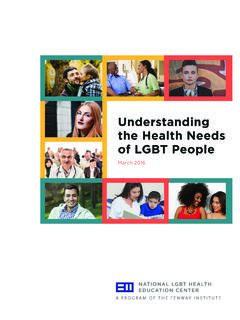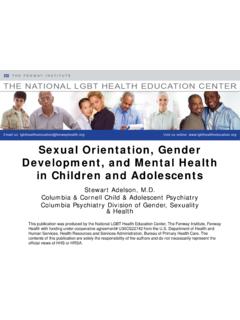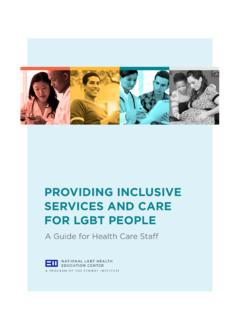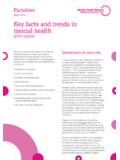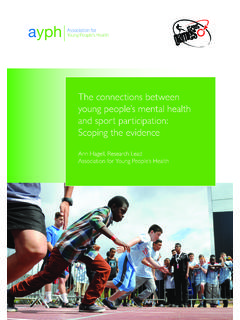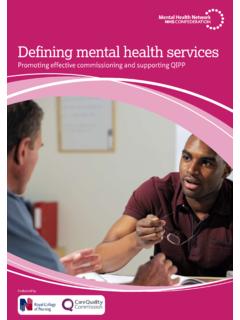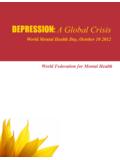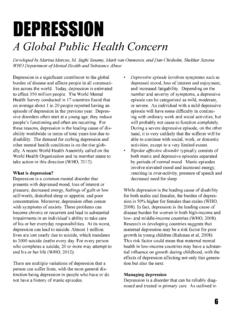Transcription of Understanding the Health Needs of LGBT People
1 NATIONAL LGBT Health EDUCATION CENTERA PROGRAM OF THE FENWAY INSTITUTEM arch 2016 Understanding the Health Needs of LGBT People1 IntroductionAlthough social acceptance of lesbian, gay, bisexual, and transgender (LGBT) People in the United States has been improving, LGBT individuals continue to face stigma and discrimination. These negative experiences, combined with a lack of access to culturally-affirming and informed Health care, result in multiple Health disparities for LGBT populations. Thus, there is an urgent need to provide inclusive, high-quality Health services to LGBT People so that they can achieve the highest possible level of Health . Here, we review LGBT concepts and demographics, discuss Health disparities affecting LGBT groups, and outline steps clinicians, Health centers, and other Health care organizations can take to provide patient-centered care for LGBT Concepts & TerminologyTo understand LGBT populations and their Health Needs , it is important to first define the dis-tinct core concepts of sexual orientation and gender identity.
2 Sexual orientation is how a person characterizes their sexual and emotional attraction to others. It can be helpful to think of sexual orientation as consisting of three dimensions behavior, attraction, and identity. These dimen-sions do not necessarily overlap in a given individual. For instance, some individuals engage in same-sex sexual behavior but do not identify as lesbian, gay, or bisexual; others experience same-sex attraction but are not sexually active with members of the same sex. In two recent studies of American adults using data from the National Health and Nutrition Examination Sur-vey (NHANES), less than half of men and women who reported sexual intercourse with mem-bers of the same sex identified as gay, lesbian, or ,2 This means that Health profession-als cannot infer an individual s sexual identity from their behavior, and vice the incomplete overlap between behavior, identity, and attraction, the terms men who have sex with men (MSM) and women who have sex with women (WSW) are often used in research and public Health settings to collectively describe those who engage in same-sex sex-ual behavior, regardless of their identity.
3 However, patients rarely use the terms MSM or WSW to describe Other than lesbian, gay, or bisexual, some patients may prefer terms such as queer or same-gender loving to describe a non-heterosexual sexual ,5 Gender identity is a person s internal sense of being a man/male, woman/female, both, neither, or another gender. Everyone has a gender identity. For most, gender identity corresponds with their assigned sex at birth. Transgender People , however, have gender identities that do not correspond with their sex at birth. Transgender persons who are assigned male sex at birth but who identify as female may call themselves transgender women, trans women, or male-to-fe-male (MTF) persons; the terms for People assigned female sex at birth but who identify as male are transgender men, trans men, or female-to-male (FTM) persons.
4 Transgender individuals may alter their physical appearance, often through hormonal therapy and/or surgery, in order to affirm their gender identity, though not all choose to do so. Identifying as transgender does not always mean affirming an identity that is strictly male or female. Some People feel their gender is a mix of male and female, neither male nor female, no gender at all, or another gender alto-gether. People whose gender identity falls outside the gender binary (male or female) may refer to themselves as genderqueer, gender fluid, non-binary, or other terms. 3 LGBT DemographicsIt is difficult to define the size and distribution of the LGBT population. This is due to several factors, including the heterogeneity of LGBT groups; the incomplete overlap between identity, behavior, and attraction which complicates attempts to categorize individuals; the lack of re-search about LGBT People ; and the reluctance of some individuals to answer survey questions about stigmatized identities and behaviors.
5 However, combining results from multiple popula-tion-based surveys, researchers have estimated that approximately of United States adults identify as lesbian, gay, or bisexual and that at least of adults identify as transgender. This amounts to approximately 9 million individuals in the United Greater numbers of individu-als have engaged in same-sex sexual behavior and report attraction to members of the same sex. In one national survey of 15 to 44-year-olds, of women and of men reported a history of same-sex sexual contact; the proportions reporting some sexual attraction to members of the same sex was for women and for In addition, the 2010 United States Census has estimated that about 646,000 households throughout the country are headed by same-sex It is likely that most clinicians have encountered LGBT individuals in their practices, whether or not they are aware of patients sexual orientations and gender Health DisparitiesHealth care professionals must be informed about LGBT Health for two reasons.
6 First, there is a long history of anti-LGBT bias in Health care that continues to affect Health -seeking behavior and access to care for LGBT individuals. Until 1973, homosexuality was listed as a disorder in the Diagnostic and Statistical Manual of Mental Disorders (DSM). Transgender status was includ-ed as gender identity disorder in the DSM up until 2013, when it was replaced by the more patient-centered term gender (Gender dysphoria refers to distress experienced by individuals whose gender identity does not correspond with their assigned sex at birth. It can manifest itself as clinically significant distress or impairment in social, occupational, or other im-portant areas of functioning. Not all transgender People experience gender dysphoria.) In keep-ing with a pathologic Understanding of homosexuality and transgender identity, many LGBT individuals were subjected to reparative therapies in the past, including electroshock treatments or Reparative therapy has been formally disavowed by many medical and profes-sional societies, but some LGBT patients continue to report discriminatory experiences in Health care settings.
7 Because of these experiences or the expectation of poor treatment, some LGBT patients are reluctant to reveal their sexual orientation or gender identity to their providers, despite the importance of such information for their Health reason that Health care providers should be informed about LGBT Health is the exis-tence of multiple Health disparities that affect these populations (Figure 1). Both an Institute of Medicine Report and the Department of Health and Human Services Healthy People 2020 initiative have documented these disparities and called for steps to address ,12 Health disparities facing LGBT populations are thought to stem from a lack of informed Health care and minority stress. Minority stress refers to the discrimination, stigma, and internalized homo- and transphobia experienced by LGBT individuals in their daily lives.
8 It has been linked to mental Health problems and other adverse Health For many LGBT individuals, the minority stress they experience on the basis of sexual orientation and gender identity intersects with inequalities associated with race, ethnicity, and social rates of HIV and other sexually transmitted infectionsLower rates of mammography and Pap smear screeningHigher rates of substance abuseHigher rates of unhealthy weight control/perceptionHigher rates of smokingHigher rates of depression, anxietyHigher rates of violence victimizationFigure 1: Selected Health Disparities Among LGBT of LGBT communities are more likely than their heterosexual counterparts to expe-rience difficulty accessing Health care. Individuals in same-sex relationships have been signifi-cantly less likely than others to have Health insurance, are more likely to report unmet Health Needs , and, for women, are less likely to have had a recent mammogram or Papanicolaou Differences in insurance coverage have resulted, at least in part, from decreased access to em-ployer-sponsored Health insurance benefits for same-sex partners and It remains to be seen how Health insurance expansion under the Affordable Care Act (ACA), as well as the le-galization of same-sex marriage throughout the country, will affect access to Health care among LGBT transmitted infections, including HIV, are major concerns in some LGBT groups, particularly MSM and transgender women.
9 MSM account for more than two-thirds of all People diagnosed with HIV each year in the United States, despite comprising only 2% of the general Young, Black MSM, in particular, are dispro-portionately affected. The number of new HIV infections in this group rose by 20% from 2008 to The racial disparity in HIV incidence does not appear to be due to differences in unsafe sexual behavior but rather other fac-tors, such as decreased access to antiretroviral therapy in non-white Data on HIV rates in transgender persons are sparse, but one systematic review estimated an HIV prevalence of approximately 28% in transgen-der women in the United Unfortunately, little is known about the risk of HIV and other sexually transmitted infections among transgender men. Aside from HIV, MSM account for 75% of reported primary and secondary syphilis infections and more than one-third of gonorrhea ,22 Outbreaks of hepatitis C infection transmitted by sexual contact have also been reported in HIV-infected MSM in urban Finally, rates of human papilloma virus-associated anal cancers among MSM are seventeen times those of heterosexual men, with even higher rates among individuals concurrently infected with other Health indicators and diseases are differentially distributed between LGBT and non-LGBT groups.
10 Compared to heterosexual adults, lesbian, gay, and bisexual individuals are more than twice as likely to Sexual minority adolescents more commonly engage in unhealthy weight control behaviors and misperceive their weight compared to their peers,26 and lesbian women have a higher prevalence of overweight and obesity compared to other In addition, gay, lesbian, and bisexual individuals experience more depression and anxiety than their heterosexual counterparts and are more likely to attempt suicide,28 transgen-der populations probably also experience higher burdens of mental distress and attempted or completed suicides, although rigorous data on this subject are ,30 In addition, substance 6use disorders affect gay, lesbian, and bisexual adults more than ,32 The higher burden of substance abuse and mental Health disorders in LGBT patients is thought to stem from the need to cope with minority stress.

